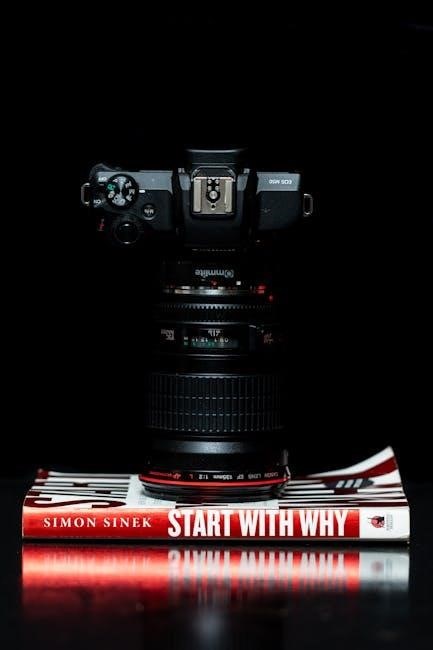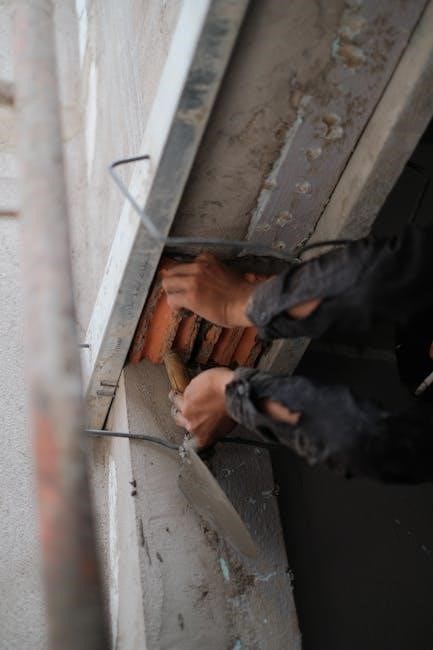Welcome to the Singer Start 1304 Manual! This guide provides comprehensive instructions for operating and maintaining your sewing machine, ensuring optimal performance and creativity.
1.1 Overview of the Singer Start 1304 Sewing Machine
The Singer Start 1304 is a versatile, mechanical sewing machine designed for household use. It features a free arm, ideal for sewing cylindrical items like sleeves and pant legs. With 6 basic stitches and a 4-step buttonhole function, it offers simplicity and efficiency. The machine is lightweight, portable, and easy to operate, making it perfect for beginners and experienced sewists alike. It includes essential accessories like a darning plate, needles, bobbins, and a seam ripper. Designed to meet international safety standards, the Singer Start 1304 is a reliable choice for handling various sewing tasks with ease and precision.
1.2 Importance of Reading the Manual
Reading the Singer Start 1304 manual is essential for safe and effective operation. It provides critical safety precautions to prevent accidents and electrical hazards. The manual explains how to properly use features like the free arm and buttonhole function. Understanding the machine’s capabilities and limitations ensures optimal performance. It also guides troubleshooting common issues, saving time and frustration. By following the manual, users can maintain the machine correctly, extending its lifespan. Compliance with international safety standards is emphasized, ensuring reliable use. Whether you’re a beginner or experienced, the manual is your key to unlocking the machine’s full potential and sewing with confidence.
1.3 Key Features of the Singer Start 1304
The Singer Start 1304 is a versatile, mechanical sewing machine designed for ease of use. It features a free arm for sewing cylindrical items like sleeves and pant legs. With a 4-step buttonhole function, it offers precision and convenience. The machine includes 6 basic stitches and 57 stitch applications, selected via a simple dial. Accessories like a darning plate, needles, bobbins, and a seam ripper are provided for enhanced creativity. Its user-friendly interface makes it ideal for beginners and experienced sewers alike. The Singer Start 1304 is a reliable, affordable option for handling various household sewing projects with efficiency and style.

Safety Instructions
This household sewing machine complies with IEC/EN 60335-2-28 and UL1594. Important safety instructions include avoiding electric shock and preventing injuries from moving parts. Always unplug the machine before cleaning or servicing.
2.1 General Safety Precautions
Always unplug the Singer Start 1304 sewing machine from the electric outlet immediately after use and before cleaning, lubricating, or servicing. Keep the machine out of reach of children and ensure proper ventilation to prevent dust buildup. Avoid exposing the machine to water or extreme temperatures. Never touch electrical parts with wet hands, and avoid overloading the machine. Regularly inspect the power cord and plug for damage. Follow all safety guidelines outlined in the manual to prevent accidents and ensure safe operation. Proper maintenance and adherence to these precautions will extend the life of your sewing machine and ensure optimal performance.
2.2 Electrical Safety Guidelines
The Singer Start 1304 sewing machine is designed to comply with international safety standards, including IEC/EN 60335-2-28 and UL1594. Always use the machine with a properly grounded power source and avoid exposing it to water or moisture. Never operate the machine with damaged cords or plugs, and ensure all electrical connections are secure. Unplug the machine before cleaning, servicing, or making adjustments. Avoid overloading the machine, as this can cause electrical issues. Keep the machine away from flammable materials and follow all electrical safety guidelines provided in the manual to prevent fire hazards or electrical shock. Proper adherence ensures safe and reliable operation;
2.3 Compliance with International Safety Standards
The Singer Start 1304 sewing machine complies with international safety standards, including IEC/EN 60335-2-28 and UL1594, ensuring safe operation for users worldwide. These standards address electrical safety, mechanical hazards, and fire prevention, providing a reliable and secure sewing experience. Compliance with these regulations guarantees that the machine meets rigorous testing criteria, minimizing risks such as electric shock or mechanical injury. By adhering to these global standards, Singer ensures the Start 1304 is suitable for household use and aligns with safety expectations across different regions. This compliance underscores Singer’s commitment to delivering a safe and durable product for its customers.

Setting Up the Machine
Setting up the Singer Start 1304 involves unpacking, threading, and installing the bobbin. Ensure all parts are correctly aligned and adjusted for smooth operation and optimal performance.
3.1 Unpacking and Initial Inspection
Begin by carefully unpacking the Singer Start 1304 sewing machine and all included accessories. Inspect the machine for any visible damage or defects. Ensure all components, such as the darning plate, needles, bobbins, and seam ripper, are included. Familiarize yourself with the machine’s exterior, including the control panel and free arm. Before proceeding, verify that the machine is free from packaging materials and debris. This step ensures a smooth setup process and helps identify any potential issues early on. Refer to the manual for a detailed list of included items and initial setup guidelines.
3.2 Threading the Machine
Threading the Singer Start 1304 is a straightforward process. Begin by placing the thread on the spool pin and guide it through the tension discs. Next, loop the thread around the take-up lever and insert it into the machine’s tension spring. Gently pull the thread to ensure it is seated correctly. Then, pass the thread through the needle’s eye from front to back. Make sure the thread is not tangled or twisted. Finally, pull the thread gently to test its tension. Proper threading is essential for smooth stitching and to prevent mechanical issues. Always use high-quality thread suitable for your fabric type.
3.3 Winding and Installing the Bobbin
To wind the bobbin, place it on the winder and secure the thread end through the bobbin’s notch. Wind the thread evenly, avoiding overfilling. Once full, trim the excess thread. Next, remove the bobbin from the winder and insert it into the bobbin case. Ensure the thread feeds smoothly through the case’s tension spring. Finally, pull the thread gently to test the tension. Properly winding and installing the bobbin is crucial for balanced stitching and to prevent thread breakage during sewing. Always use thread that matches your fabric type and ensure the bobbin is correctly seated for optimal performance.
3.4 Adjusting Tension
Adjusting the tension on your Singer Start 1304 ensures even stitching and prevents fabric puckering. To adjust the upper thread tension, turn the dial located on the front of the machine. For the bobbin tension, gently pull the thread to check if it feeds smoothly. If the tension is too tight, the thread may break; if too loose, stitches may be uneven. Use the small screw on the bobbin case to make fine adjustments. Always test the tension by sewing on a scrap piece of fabric before working on your final project. Proper tension ensures consistent stitch quality and optimal sewing performance.

Understanding the Machine
The Singer Start 1304 is a versatile sewing machine with a free arm for cylindrical sewing and a range of included accessories for various projects, ideal for beginners and experienced sewists alike.
4.1 Parts and Accessories Included
The Singer Start 1304 sewing machine comes with a variety of essential parts and accessories to enhance your sewing experience. These include a darning plate for free-motion sewing, multiple needles for different fabric types, bobbins for winding thread, and a seam ripper for correcting mistakes. Additional accessories like a zipper foot and buttonhole foot are also provided, allowing you to tackle various sewing projects with ease. Each part is designed to ensure optimal performance and versatility, making the Singer Start 1304 a complete sewing solution for both beginners and experienced sewists. These accessories are neatly organized and stored in a convenient compartment.
4.2 Control Panel Overview
The Singer Start 1304 features a user-friendly control panel designed for easy operation. The panel includes a stitch selection dial that allows you to choose from various stitch patterns with a simple turn. A backstitch lever is conveniently located for reinforcing seams. The control panel also includes a power switch and a light switch to illuminate the work area. Additional buttons or dials may be present for adjusting stitch length and width, ensuring customization for different fabrics and projects. The intuitive layout makes it easy for both beginners and experienced sewists to navigate and utilize the machine’s full potential effectively.
4.3 Accessories and Their Uses
The Singer Start 1304 comes with a variety of accessories to enhance your sewing experience. A darning plate is included for free-arm sewing, allowing you to work on cylindrical items like sleeves and pant legs with ease. Additional accessories include a set of needles, bobbins, and a seam ripper for quick corrections. The machine also comes with a screwdriver for adjusting or tightening parts. These accessories are designed to make sewing efficient and convenient, catering to both basic and advanced projects. Proper use of these tools ensures optimal performance and longevity of the machine, helping you achieve professional-quality results in every stitch.

Basic Operations
The Singer Start 1304 offers straightforward operations, including selecting stitch patterns, sewing straight stitches, and using the backstitch function. The free arm facilitates sewing cylindrical items effortlessly.
5.1 Selecting Stitch Patterns
Selecting stitch patterns on the Singer Start 1304 is straightforward. Use the stitch selection dial to choose from 6 basic stitches and 57 stitch applications. Each stitch is designed for specific fabrics and tasks, such as straight stitching for general sewing or zigzag for elastic materials. Turn the dial to your desired stitch, and the machine will automatically adjust the stitch length and width. This feature ensures consistent results and simplifies the sewing process. Always refer to the stitch chart in your manual for guidance on selecting the right stitch for your project.
5.2 Sewing Straight Stitches
To sew straight stitches on the Singer Start 1304, select the straight stitch option using the stitch selection dial. Ensure the machine is properly threaded and the tension is adjusted for even stitching. Place your fabric under the needle, aligning the edge with the machine’s guide. Gently press the pedal to start sewing, maintaining a steady pace. Use the free arm for small or cylindrical items like sleeves. Keep the fabric smooth and guide it evenly to achieve straight, consistent stitches. This stitch is ideal for general sewing, repairs, and piecing fabric together.
5.3 Using the Backstitch Function
To use the backstitch function on the Singer Start 1304, begin by selecting the straight stitch or reverse stitch option. Engage the backstitch by gently pulling the reverse lever located on the front of the machine. This feature is ideal for securing seams at the beginning and end of your stitching. Sew a few reverse stitches, then release the lever to continue sewing forward. The backstitch ensures strong and durable seams, preventing fraying. Guide the fabric smoothly and maintain steady pressure on the pedal for consistent results. This function is particularly useful for reinforcing hems, pockets, and other stress points in your projects.
5;4 Sewing Cylindrical Items with the Free Arm
The Singer Start 1304’s free arm is perfect for sewing cylindrical items like sleeves and pant legs. To use it, detach the auxiliary bed to access the free arm. Position the fabric around the arm, aligning the edge with the edge of the presser foot. Select a straight stitch or suitable stretch stitch for the fabric type. Guide the fabric smoothly, maintaining steady pressure on the pedal. This feature allows easy navigation around curves, ensuring even stitching. For best results, use a walking foot or zipper foot if available. Regularly check tension to prevent bunching or loose stitches. This makes sewing cylindrical items efficient and precise.

Advanced Features
The Singer Start 1304 offers advanced features like 57 stitch applications, 4-step buttonholes, and adjustable stitch length and width for versatility in complex sewing projects.
6.1 Creating Buttonholes
The Singer Start 1304 allows you to create professional-looking buttonholes with ease. Using the 4-step buttonhole feature, you can sew consistent and precise buttonholes for shirts, pants, and more. Simply place your fabric under the machine, select the buttonhole stitch using the dial, and follow the guided steps. The machine will automatically sew the perfect buttonhole. For best results, use a stabilizing material like interfacing and ensure the fabric is taut. Always refer to the manual for detailed instructions and tips on achieving flawless buttonholes every time. This feature is ideal for both beginners and experienced sewists looking to enhance their projects with professional finishes.
6.2 Adjusting Stitch Length and Width
The Singer Start 1304 allows you to customize your stitches by adjusting both the stitch length and width. To modify the stitch length, simply turn the stitch length dial located on the front of the machine. Similarly, the stitch width can be adjusted using the stitch width dial. These adjustments enable you to tailor your stitches to suit various fabrics and sewing projects. For delicate fabrics, shorter stitch lengths are recommended, while heavier materials may require longer stitches. Always test the settings on a scrap piece of fabric before sewing your final project to ensure the desired results. This feature adds versatility to your sewing experience, making it suitable for a wide range of tasks.
6.3 Using the Darning Plate
The darning plate is a useful accessory for the Singer Start 1304, enabling free-motion sewing such as darning or embroidery. To use it, first ensure the machine is not threaded, as the plate must be attached without interference. Locate the darning plate and snap it securely onto the machine’s free arm. Once in place, lower the feed dogs to prevent fabric movement. You can now sew in any direction, allowing for precise control over your stitches. This feature is ideal for repairing torn fabric or creating decorative embroidery patterns. Always test the setup on scrap fabric before working on your final project to ensure smooth operation.

Maintenance and Care
Proper maintenance ensures the Singer Start 1304 operates smoothly and lasts longer. Regularly clean the machine, lubricate moving parts, and store it in a dry place.
7.1 Cleaning the Machine
Regular cleaning is essential to maintain the Singer Start 1304’s performance. Turn off and unplug the machine before cleaning. Use a soft brush to remove dust and lint from the interior, paying attention to the bobbin area and feed dogs. A lint remover or small vacuum can also be used gently. Avoid using liquids or harsh chemicals, as they may damage the machine. Wipe the exterior with a dry cloth to prevent rust. Clean after each project to prevent fabric residue buildup. For thorough maintenance, clean the machine every 1-2 months, depending on usage frequency. This ensures smooth operation and longevity.
7.2 Lubricating the Machine
Lubricating the Singer Start 1304 is essential for smooth operation and longevity. Use Singer-branded oil or a high-quality sewing machine oil. Apply a few drops to the bobbin hook area and other moving parts as indicated in the manual. Avoid over-lubrication, as excess oil can attract lint and dust. Lubricate every 1-2 months or when you notice increased noise or friction. Turn the handwheel gently to distribute the oil evenly. After lubricating, sew a few straight stitches on scrap fabric to ensure proper oil circulation. Never use household oils, as they may damage the machine. Regular lubrication prevents wear and keeps the machine running efficiently.
7.3 Storing the Machine Properly

Proper storage of the Singer Start 1304 ensures its longevity and performance. After cleaning and lubricating, store the machine in a cool, dry place away from direct sunlight. Use the original hardcover case or a sturdy, dust-proof cover to protect it. Avoid storing it in humid or extreme temperature environments. Keep the machine upright to prevent oil from leaking into internal components. If storing for an extended period, avoid leaving the needle in the machine. Store accessories separately in a protective pouch to prevent loss or damage. Regularly inspect stored items to ensure they remain in good condition. Proper storage maintains the machine’s efficiency and readiness for future use.

Troubleshooting Common Issues
This section helps identify and resolve common problems with the Singer Start 1304, ensuring smooth operation by addressing issues like thread breakage or machine malfunction effectively.
8.1 Common Problems and Solutions
Identify and resolve common issues with the Singer Start 1304. Thread breakage may occur due to improper tension; adjust the tension dial. If stitches are uneven, check needle alignment and ensure correct stitch selection. Machine noise could indicate improper lubrication or debris; clean and oil regularly. Bobbin issues, such as poor winding, can cause stitching problems; rewind the bobbin correctly. For error prevention, always unplug the machine before cleaning or servicing. Regular maintenance, like oiling moving parts, prevents mechanical failures. If issues persist, consult the manual or contact Singer customer support for professional assistance. Troubleshooting ensures optimal performance and extends machine lifespan effectively.
8.2 Error Prevention Tips
To ensure smooth operation of the Singer Start 1304, follow these error prevention tips. Always read the manual thoroughly before use. Regularly clean the machine to remove dust and debris, which can cause mechanical issues. Properly thread the machine, ensuring the thread is seated correctly in the tension discs. Use the correct needle type for your fabric to avoid breakage. Avoid overloading the machine with thick fabrics or multiple layers. Store the machine in a dry, cool place when not in use. Perform routine maintenance, such as oiling moving parts and dusting internal components. These practices will extend the machine’s lifespan and prevent common errors, ensuring reliable performance for all your sewing projects.
8.3 When to Contact a Professional
If you encounter issues beyond basic troubleshooting, it may be necessary to contact a professional. This includes situations where the machine produces unfamiliar noises, has electrical malfunctions, or suffers internal damage. If you notice broken or worn-out parts that you cannot replace yourself, seek expert assistance. Additionally, if the machine consistently fails to operate correctly after following troubleshooting steps, professional servicing is recommended. Always use authorized Singer service centers to ensure repairs are done correctly and to maintain your machine’s warranty. Regular professional maintenance can also prevent future issues and keep your Singer Start 1304 functioning optimally.

Additional Resources
Access the Singer Start 1304 manual, online guides, and customer support for troubleshooting, maintenance, and operation tips to optimize your sewing experience.
9.1 Accessing the Full Instruction Manual
The Singer Start 1304 manual is available for free download as a PDF file. You can access it directly from Singer’s official website or through authorized retailers. Simply visit the support section, enter your product model, and download the manual in English or other languages. The document covers setup, operation, and troubleshooting, ensuring you make the most of your sewing machine. Additionally, the manual can be found on third-party sites like ManualsLib or Scribd. Always verify the source to ensure authenticity. The manual is also included with your purchase, either as a physical copy or a digital version on the product CD.
9.2 Online Guides and Tutorials
In addition to the manual, Singer provides online guides and tutorials to help users master the Start 1304. These resources include step-by-step videos and interactive demos. You can find them on Singer’s official website or platforms like YouTube. Tutorials cover basic operations, advanced features, and troubleshooting. They are ideal for visual learners who prefer hands-on instruction. Many third-party sewing communities also offer tips and tricks for getting the most out of your machine. These online resources are updated regularly to address common questions and provide creative ideas for projects. They complement the manual, offering a more dynamic learning experience for users of all skill levels.
9.3 Customer Support and Service Centers
Singer offers comprehensive customer support for the Start 1304 through various channels. Visit their official website to access live chat, email support, and a dedicated phone hotline. Additionally, Singer operates a global network of authorized service centers, where trained professionals can assist with repairs, maintenance, and troubleshooting. These centers ensure that users receive genuine parts and expert care, maintaining the machine’s performance. For convenience, Singer’s website provides a locator tool to find the nearest service center. Whether you need technical assistance or general inquiries, Singer’s customer support team is available to help you maximize your sewing experience with the Start 1304.
9.4 Frequently Asked Questions
Users of the Singer Start 1304 often inquire about basic operations, troubleshooting, and maintenance. Common questions include how to thread the machine, resolve thread jams, and adjust stitch tension. FAQs also cover bobbin installation, buttonhole creation, and error prevention. Many users ask about the machine’s compatibility with various fabrics and accessories. Additionally, questions about cleaning, lubrication, and storage are frequent. The manual addresses these topics in detail, ensuring users can resolve issues quickly. For further assistance, Singer’s customer support provides answers to these FAQs and more, helping users optimize their sewing experience with the Start 1304.
